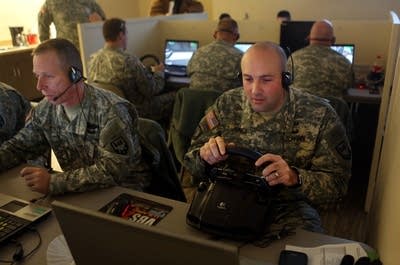Combat training simulators save money, improve skills, Minnesota National Guard says

There's nothing new about a roomful of guys playing video games. But at the National Guard's Camp Ripley in central Minnesota, one video game could have life or death consequences.
Minnesota National Guard officers are using simulators to train troops in very real and potentially deadly skills -- from shooting to driving to combat.
Each soldier plays a special role -- be it driver, truck commander or gunner. What each sees in the game is tailored to that job. That could place them behind the steering wheel or the barrel of a gun.
About 40 soldiers have come from National Guard units around the country for the training, which is deadly serious as the troops are practicing searching for improvised explosive devices and insurgents -- skills that could keep them and others alive overseas. Using joysticks and plastic steering wheels, they hunch over computers in clusters meant to simulate three-man combat teams.
Create a More Connected Minnesota
MPR News is your trusted resource for the news you need. With your support, MPR News brings accessible, courageous journalism and authentic conversation to everyone - free of paywalls and barriers. Your gift makes a difference.
• Photos: Video game sharpens Minn. soldiers' skills

Under a wall-sized projection of the game, Sgt. First Class Todd Laudenbach controls the scenarios troops encounter.
"They can actually add garbage cans, TVs, stuff laying out on the road," he said. "If they take the time to add that stuff they can make it as realistic as it was over there."
The goal of the Virtual Battlespace system, Laudenbach said, is to prepare troops for the unexpected and train them to work as a team. The video game convoy rolls through a typical Afghan mountain village. Long stretches of dusty ground are punctuated by mud dwellings and snow-capped mountains.
During one session, the convoy is attacked by unseen insurgents.
"All units, all units be advised, get back into a defensive formation around the Strykers," comes an order from unit commanders."We are going to mount up and move out."
A number of other militaries around the world including the UK, Canada and Australia also use the software. A U.S. Army spokesperson wouldn't say how much the simulators cost to produce and customize. But Col. Scott Sauver, Camp Ripley's post commander, said it's a bargain because virtual training gives troops a head start on learning.
"It allows us to focus their training on exactly the skills that they need so that they can react at a moment's notice. We call it muscle memory."
"It saves a lot of money, and quite frankly, as a former battalion commander that has done this kind of a convoy security mission in that environment, it saves a lot of lives," Sauver said. "It allows us to focus their training on exactly the skills that they need so that they can react at a moment's notice. We call it muscle memory."
In addition to these video game simulators, the guard uses other training technology.
Soldiers who need to practice their marksmanship enter a black box theater, where enemy troops are shown on a giant screen. They fire fake weapons that look and feel like the real thing. The system provides a constant stream of feedback to personalize the training.
Soldiers also train in replicas of tanks and other combat vehicles without the risk of damaging real equipment or weapons or hurting themselves.
Staff Sgt. Anthony Folstad, of Hibbing, Minn., said the system is surprisingly realistic for a game.
"Being in the scenario it gives you a sense of reality to it, especially when you can have a soldier in the system go down and you have to react and get that soldier out," he said. But Folstad says it's no replacement for the real thing.
Guard officials say it's not meant to be. Troops progress to field training only after mastering the simulators. And when they do, they say, they're more advanced than in the past.


